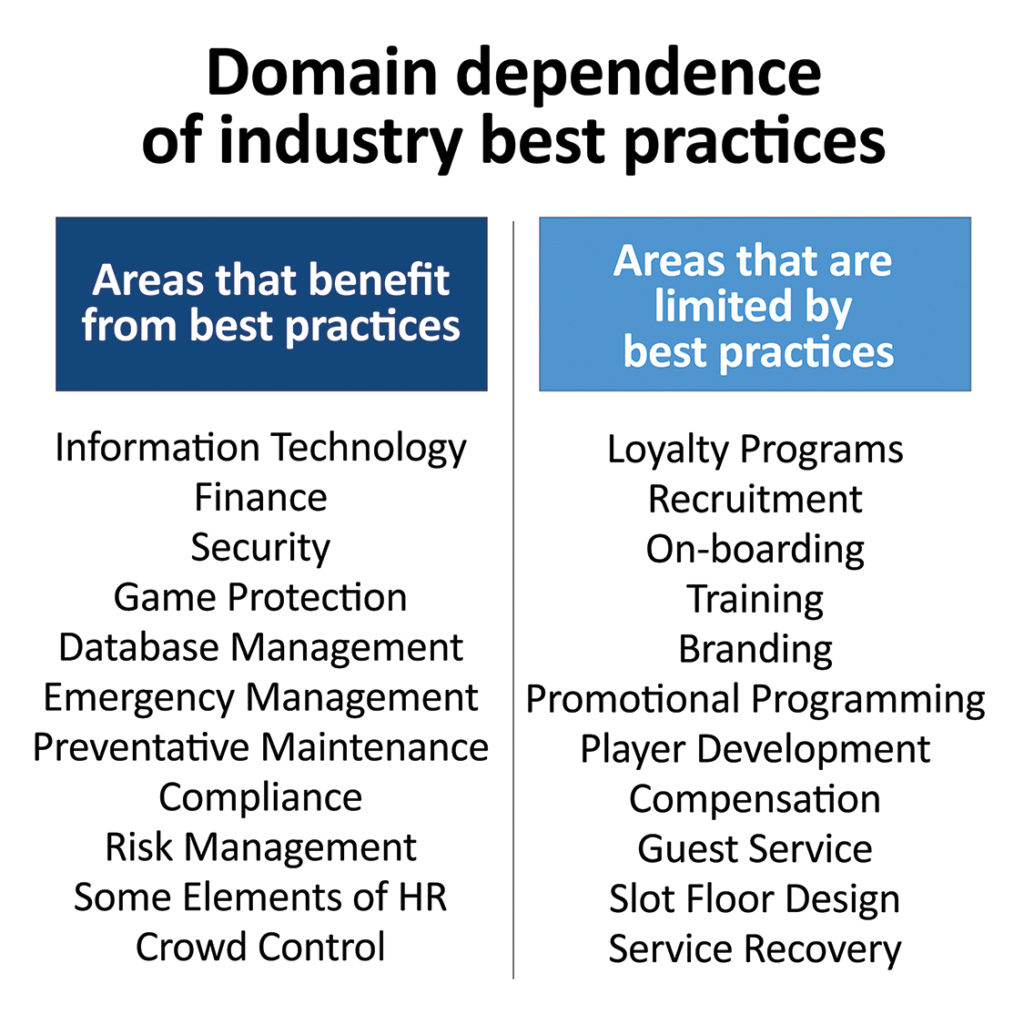by Dan White
Industry best practices are ubiquitous. They can apply to every division within a casino. They are touted at industry trade shows and conferences and from any number of sources. Best practices are defined as the procedures prescribed as the correct or most effective way to achieve an outcome. In many cases, adopting best practices can strengthen an organization while reducing risk and waste along the way. In other cases, however, they might be limiting a casino’s ability to thrive in a competitive market.
Perhaps a helpful way to view this is to consider that best practices are domain dependent; some work very well in some areas while others may be restrictive. The table illustrates this idea. The left-hand column features items that benefit from adopting best practices, while the right-hand column includes items that are limited by them.

This is not an exhaustive list, of course, but it does demonstrate the general concept. There are some distinct, common attributes for both columns.
For example, items in the left-hand column tend to be in alignment with managing risk or protecting an organization from unforeseen but potentially catastrophic events. In such cases, there is far more to be gained by understanding what has happened elsewhere. It is a form of crowd sourcing our practices and procedures. Industries are able to learn from failures and errors and then quickly incorporate new practices to constantly refine the process. This is a powerful and effective way to strengthen systems.
That is not necessarily the case for items in the right-hand column. These items represent ways in which casinos can differentiate. These are areas in which being different is generally a good attribute. How a casino recruits, trains, lays out the slot floor or builds a new brand campaign are all areas in which a distinct competitive advantage can drive market share growth and long-term success. While there may be cautionary tales of woefully executed programs to be aware of, there is less to gain from trying to adopt practices of other casinos in these areas.
The left-hand column also features items that, in many respects, have fewer paths to success. For this reason, they tend to fit well with prescriptive, “how-to” methods. There are simply far fewer ways to do something well for many of these areas. For example, in terms of crowd control or event management, there may be a limited number of protocols to ensure safe egress (clearly marked exits, clutter-free paths to exits, etc).
But that is not true for items in the right-hand column. For many of these areas, there are hundreds, if not thousands of ways to build, implement and operate a program. This represents opportunity for casino operators. For example, recruitment efforts can benefit from embracing creative ideas outside conventional practices (how and where you seek talent, interview process, offer structures, etc.). In such cases, creating distinction can be a significant advantage.
Another way to look at the table is to consider the asymmetrical outcomes for both sides if best practices are not adopted; they move in opposite directions. For example, if an organization chose not to follow any of the best practices for items in the left-hand column, the exposure would be negative in nature. For instance, a casino that eschews best practices for network security measures and instead seeks to figure it out entirely on their own may succeed in doing so, but there is very little upside to this approach. All the risk associated with such a decision is negative and the exposure in enormous.
That is not necessarily true for items in the right-hand column, where doing something different from best practices likely increases exposure to a positive outcome. For example, building out a new loyalty program provides an opportunity to create a unique program that may not adopt any of the best practices for players clubs. The downside is likely minimal, but the upside is potentially unbounded.
There is another perhaps less obvious downside to adopting best practices; the reduction of innovation. By their very nature, industry-wide best practices are prescriptive; they provide how-to measures for processes and programs. Adopting such practices without some critical analysis may reduce the amount of innovation happening at a property. In that regard, it can also curb creative problem solving and even, in some cases, foster an environment of dogmatic thinking. In other words, it is possible that over-reliance on best practices creates a culture where independent thought takes a back seat to conventional wisdom. This can create problems for casinos that that must rely on differentiation to stimulate growth.
So what do casinos do about this? How do casino operators move to a more balanced approach to industry best practices? A good place to start is to make a list or add to the one featured earlier. This would be an evaluation of all areas of the operation. Determine which column they belong in.
The next step is to do a quick inventory of current practices for each of those areas. Which currently rely on industry best practices and which do not? And, perhaps more importantly, are there any items in the left-hand column that do not currently embrace all industry best practices. Remember, this is where the greatest risk resides. Being aware of that risk and exposure is critical.
Once an initial assessment is complete, casino operators can begin to focus on strengthening left-hand column items and re-imagining right-hand column items. This allows casinos to view the right-hand items in a completely new light. From here, the process is not to make changes for the sake of making changes. Instead, a critical review of current programs and practices can start to identify the areas of greatest opportunity. “Why do we do things they way we do? What are we doing now that makes us more like our competitors and how can we do it differently to create differentiation?”
This final phase is one that will take time, patience, and commitment. Keep in mind that the items in the right-hand column are highly conducive to trial and error. Iterations and variations of ideas are good in this regard. Testing concepts and new ways of doing business exposes casinos to tremendous upside.
Ultimately, the end goal is to discover the best practices for your specific organization; practices that embrace the unique combination of people, resources, attributes and qualities. These practices may not work quite as well anywhere else. They are the outcome of a process designed to create differentiation and set you apart from the competition.
Dan White is the owner of Dan White & Associates, a casino marketing and strategy consulting firm. He can be reached by calling (360) 890-1433 or email dan@danwhiteassociates.com.














































